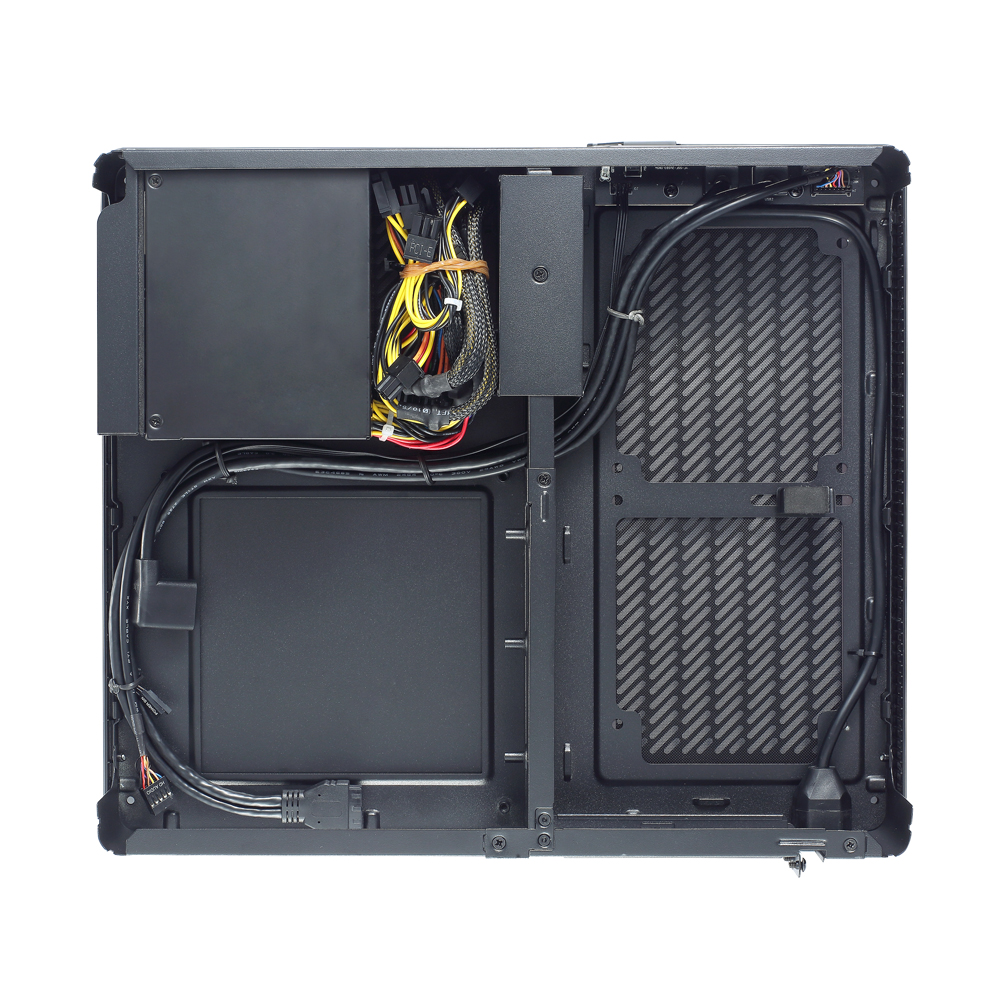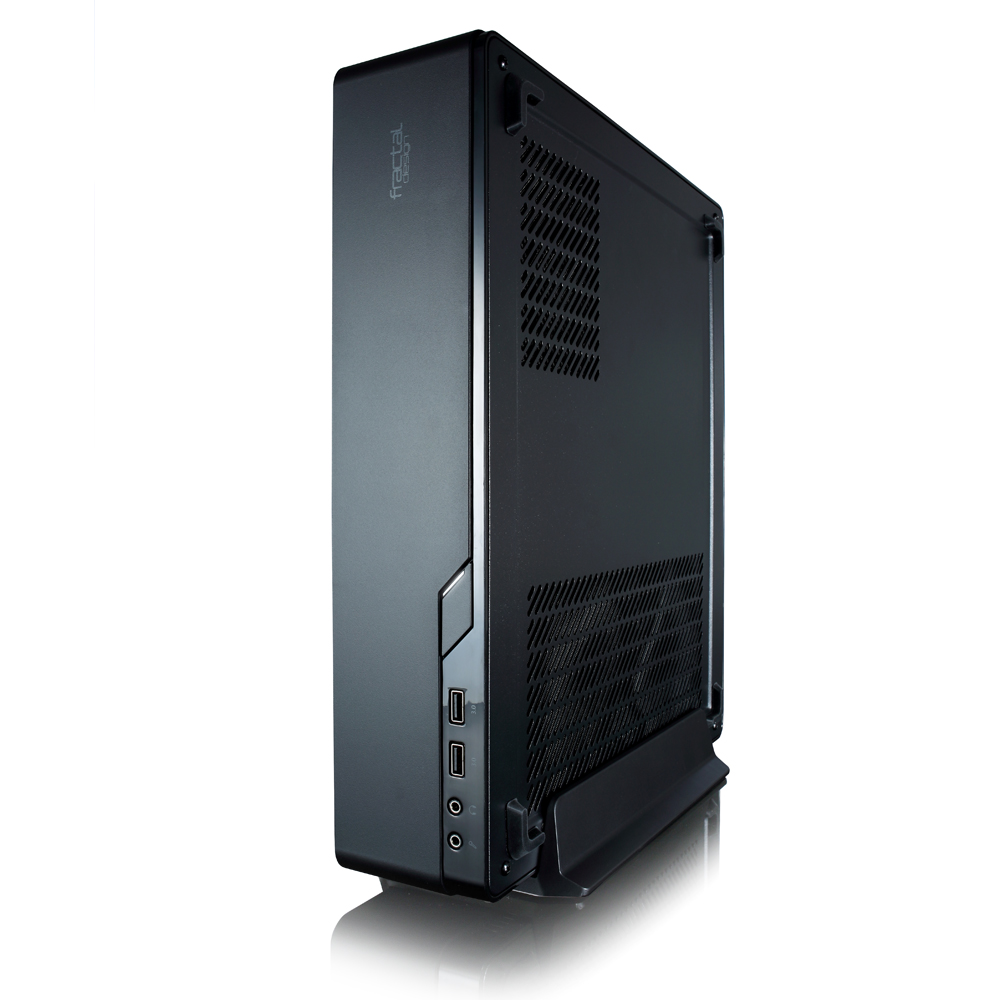Fractal Design Introduces Core 500, Node 202 Cases, Updates Kelvin Water Cooling Series
Fractal Design is once again at Computex. The Swedish-based company is well known for its cases, and at the industry's biggest show, it's adding two more to its roster, and it's also introducing a few upgrades to its entire group of water cooling products.
Two New Cases
Fractal Design has developed two mini-ITX PC cases for users who want high-performance parts in the smallest space possible.
One of the greatest difficulties of building a mini-ITX system is trying to get all the performance you want from a full desktop system in such a small confined space. The reduced form-factor creates a challenge in terms of fitting in certain physically larger components, such as PSUs and GPUs, and cooling the cramped space can be problematic.
To overcome these difficulties, cases like the new Fractal Design Core 500 do the only thing they can do: they extend the size of the case to allow larger components and allow more airflow. Though these cases are larger than the traditional mini-ITX form factor, they are still smaller than micro-ATX cases and can accommodate full-sized GPUs and many PSUs. They also promise better cooling.
This particular case was optimized for cooling. Inside is a pre-installed Fractal Design Silent Series R3 140 mm rear exhaust fan, which should be relatively quiet while helping to cool the system. The case has sufficient space for large CPU coolers, supporting a cooler tower up to 170 mm in height, and supporting large 280 mm radiators for water cooling.
In addition, the case can hold plenty of drives for a mini-ITX case, including three 3.5-inch drives, three 2.5-inch drives, and one 5.25-inch drive simultaneously.
The case is expected to cost $59.99 when it hits the market, but no release date is set as of yet.
Get Tom's Hardware's best news and in-depth reviews, straight to your inbox.
The company also has another mini-ITX case called the Node 202 which measures 82 x 377 x 330 mm (HxWxD) and weighs a little over 7 pounds. It has two 2.5-inch drive bays, two expansion slots, and two USB 3.0 ports in the front along with a headphone and mic jack. The maximum height for a CPU cooler it can accommodate is 56 mm, and the specs say there are two additional 120 mm fan placements in the graphics card chamber. Speaking of the graphics card, The Node 202 allows graphics up to 145 x 310 x 47 mm (HxLxD).
Aside from the chassis, the package also comes with three dust filters and a stand so you can place it in either the traditional horizontal position or free up space on your desk by placing it upright.
For power supplies, it's compatible with SFX variants up to 130 mm long. However, you can also purchase the case with an included SFX 450 W PSU from the company's Integra series. It's an 80 PLUS Bronze-rated model with two PCI-E 8-pin connectors, two SATA connectors, one ATX 24-pin (20+4) connector, and an ATX 12V 8-pin (4+4) connector.
The Node 202 and Integra SFX 450W combo will cost you $139.99, but if you already picked out a PSU, the standalone case will cost $79.99.
While these two cases both support the same motherboard form factor, the Node 202 is a smaller case than the Core 500. Building for the SFF crowd is no small feat, with the reduction of the interior space posing a big challenge to development. However, Fractal Design seemed to be able to make not one, but two more cases to add to two of its four case lineups.
Keep Your CPUs Cool
In addition to cases, the company also took some time and gave its water cooling products a few changes. The Kelvin series has three models: the S36 features three radiators with a total measurement of 30 x 394 x 397 mm (HxWxD), the S24 has two radiators and measures 30 x 124 x 275 mm (HxWxD), and the T12 only has one radiator with a measurement of 46 x 132 x 163 mm (HxWxD).
The first of the big changes is to mounting specs. Adding to its large list of supported sockets for both Intel and AMD processors, these updated coolers now support the 2011-v3 socket. The old fans were also swapped out for Dynamic GP-12 PWM fans, which apparently provides larger airflow and operates more quietly. The new fans also have speed variations between 500 and 2000 RPM. A low pump speed cable was also added to decrease sound, and the radiator screws are now replaced with PH2 heads. Additionally, the fill port for the pump now has a coin slot so you can access it without the need of an Allen key.
The final changes are a minute, but essential detail: A small groove is added to the bottom of the fittings, which should make it more difficult to accidentally remove the tubes. The tubes are also changed to have a slightly harder material, but it's unclear as to the specific material used.
The S36 will cost you $139.99, the S24 will cost $119.99, and the T12 is $99.99. With these upgrades and its ability to work with expansions to your water cooling build, the Kelvin coolers might be a considerable choice whether you're a water cooling rookie or veteran.
Options And Improvements
These latest offerings from Fractal Design continue to appeal to its loyal customers. The Node 202 and Core 500 should please the SFF crowd, and the updates to the Kelvin water cooling series show that the pursuit of cooler temperatures and quieter systems can always be improved.
We're going to see Fractal Design at Computex, so we're going to get a closer look at what the company has to offer for the latter half of the year.
Follow us @tomshardware, on Facebook and on Google+.
-
jossrik "S36 features three radiators with a total measurement of 30 x 394 x 397 mm (HxWxD)"Reply
The biggest water cooler comes with three radiators? The measurements seem off too... I'm thinking it will only fit into cases with a huge side window that you can take out. 360x360x30 would be 9 120mm fans 30mm deep. -
Darkbreeze More and more these cases are looking like high end versions of the old flat AT style computer cases that were popular in the early 90's and back and are still used in some small form factor proprietary designs. Personally, if the design fits your environment better, I kind of like it as it takes stress from the vertical placement of heavy components like the CPU cooler and GPU card and translates it to the slot instead of weak points on the hardware. I'd like to see more of this, just not in vanilla flavored varieties similar to what was common back then. Considering that most those cases could be easily placed on an entertainment center or small table, the comparisons are relatively parallel aside from cooling and motherboard form factor differences.Reply -
Arabian Knight Hello Fractal Design,Reply
Regarding your new Core 500 case ,
I hope you did not start mass production ...
here is the minor thing you missed ,
the case width is 250 mm and looking at the rear of the case I can see that you wasted 20mm to the left where the power plug is installed.
here is the catch , Cards like Titan Z are THREE SLOTS CARDS.
so this 20 mm to the left should have been used to the RIGHT making it a 3 slots case instead of 2 slots case.
MANY cards are 3 slots . and MANY people will use this case with DUAL GPU 3 slots cards coming in the near future for the lack of slots in itx form factor!
it is a WONDERFUL CASE !!! but why on earth waste 20 mm to the left ? use those 20 mm to the RIGHT making it a 3 slots case .
as for the power plug , it can be placed over the third slot there is enough space above the cards because you allowed 140 rear fan in the case.
I hope you did not go for mass production :(
keep it 250 width but use the that for 3 slots and put the power plug over the third slot place !
here is my mod to your case :
http://i44.photobucket.com/albums/f11/samer1970/samer_zpsfvxb854k.jpg -
2Be_or_Not2Be ReplyMore and more these cases are looking like high end versions of the old flat AT style computer cases that were popular in the early 90's and back and are still used in some small form factor proprietary designs.
If they had moved the Node 202's graphics cooling vents to the opposite side, I think I could have made a flat desktop case out of it & just sit my monitor on top like the old days!
-
Darkbreeze Exactly. To be honest, thermally they're probably more efficient than tower cases. With less actual airspace internally, the air is exchanged at a higher rate, and there are less opportunities for air pockets and eddies. This is observed in server chassis where the air exchange is so efficient they generally don't need separate fans for the CPU cooler heatsinks. Of course, if there's overclocking and big cards installed, you want cooling on those items, but the faster air exchange with these type of cases is still probably more efficient if you can shrink the size of the case and still use the same size fans you'd use on an ATX tower.Reply





